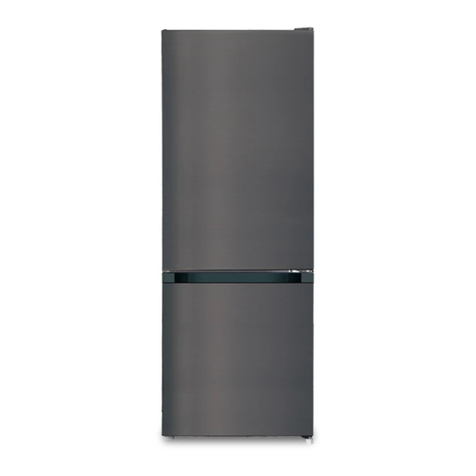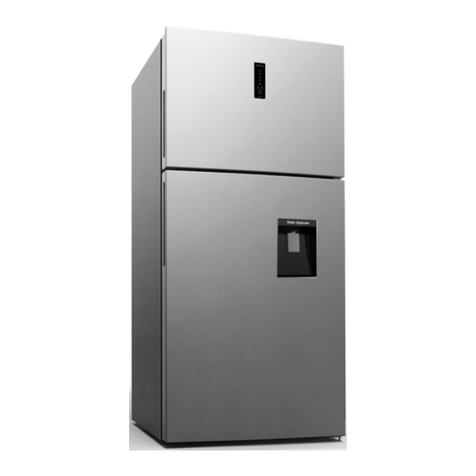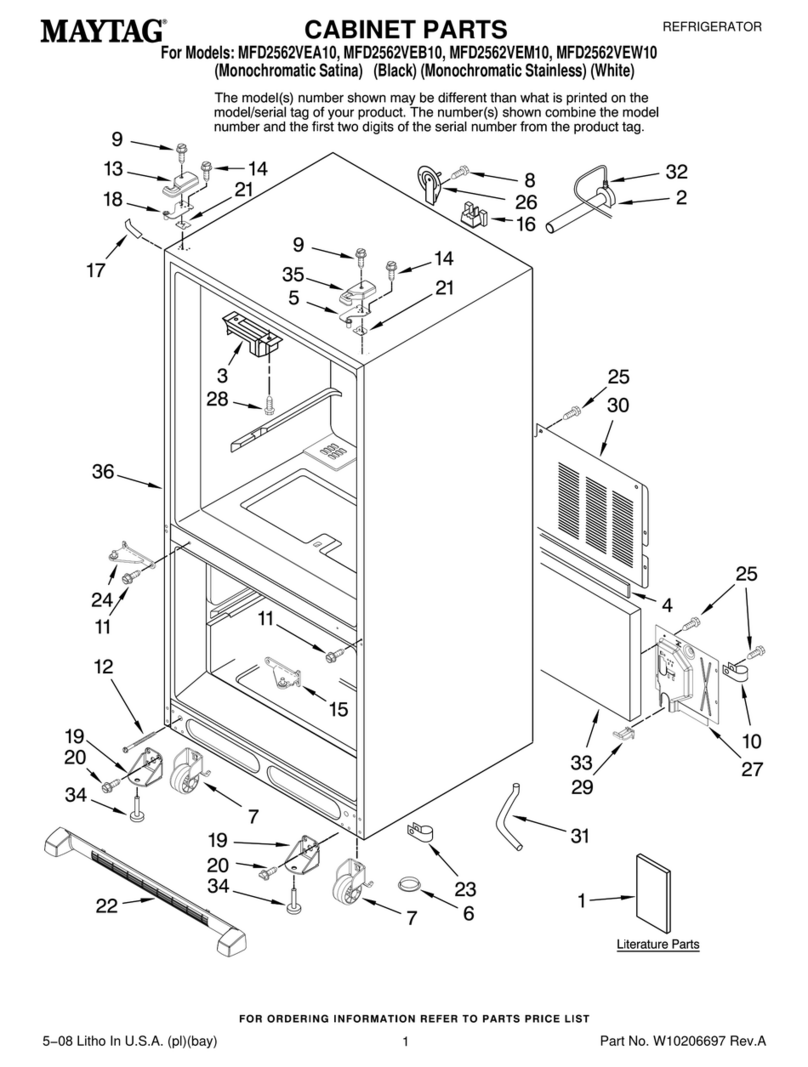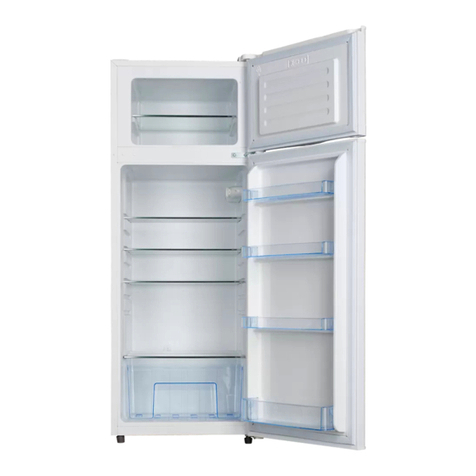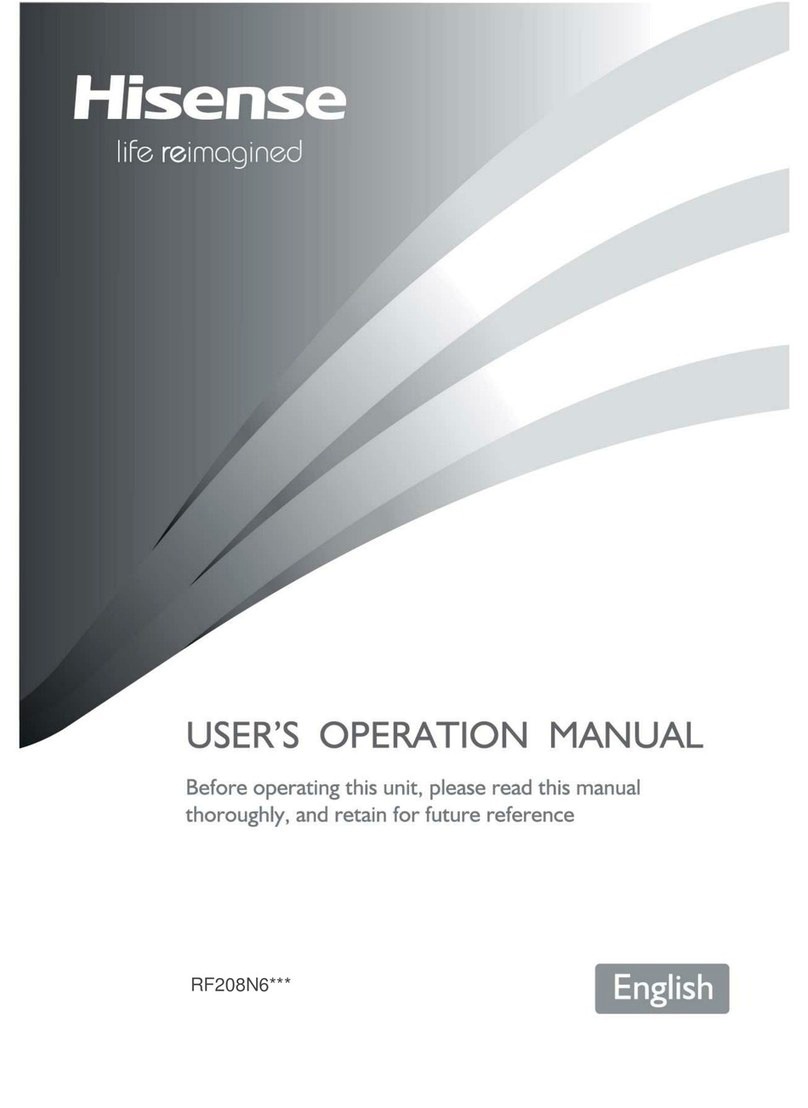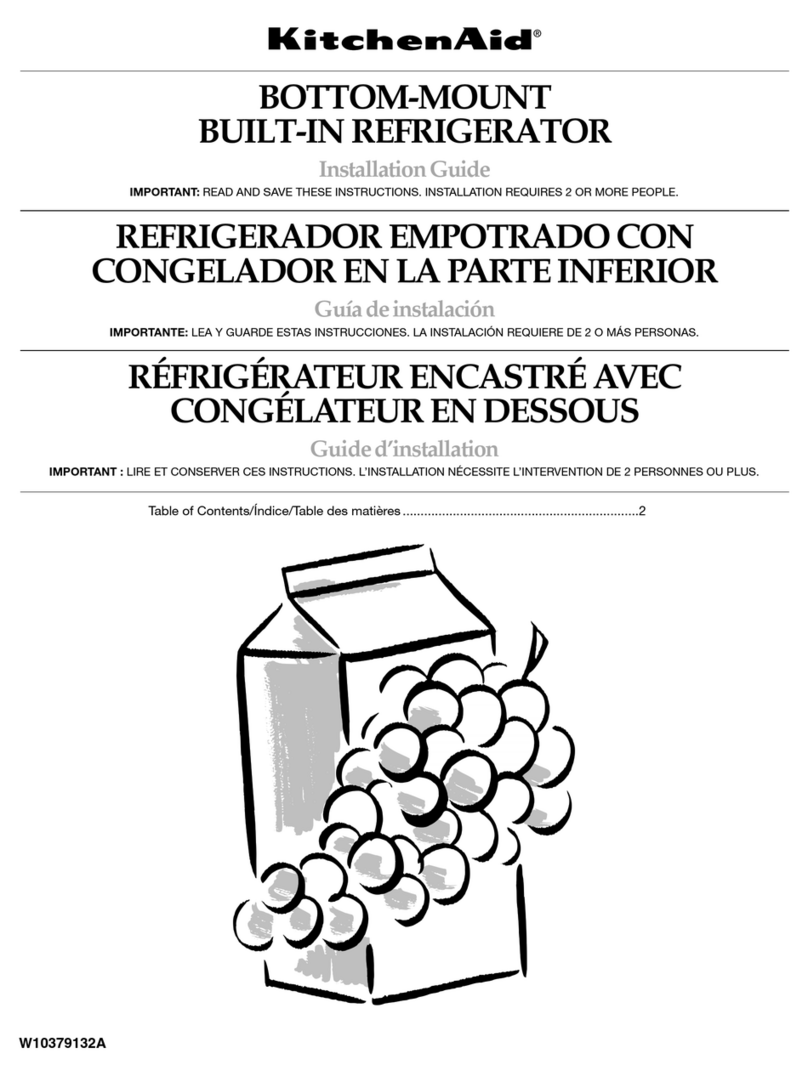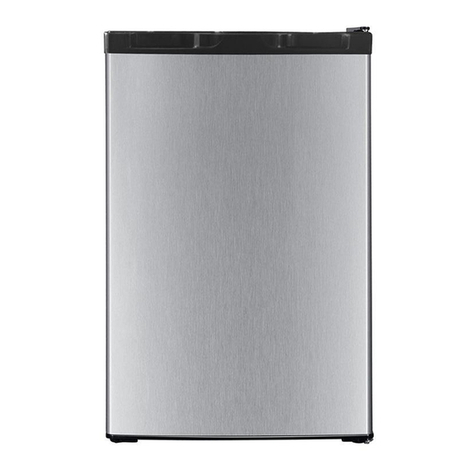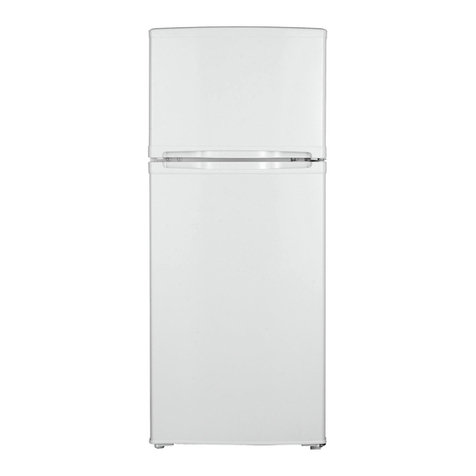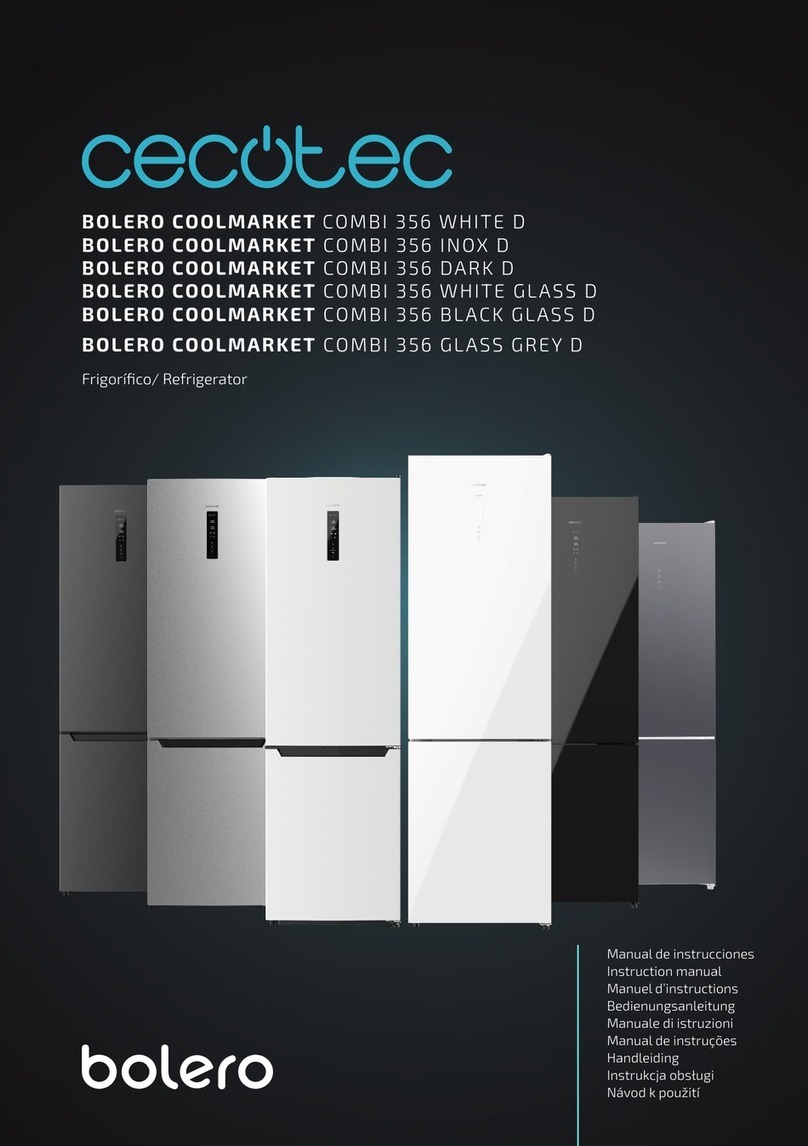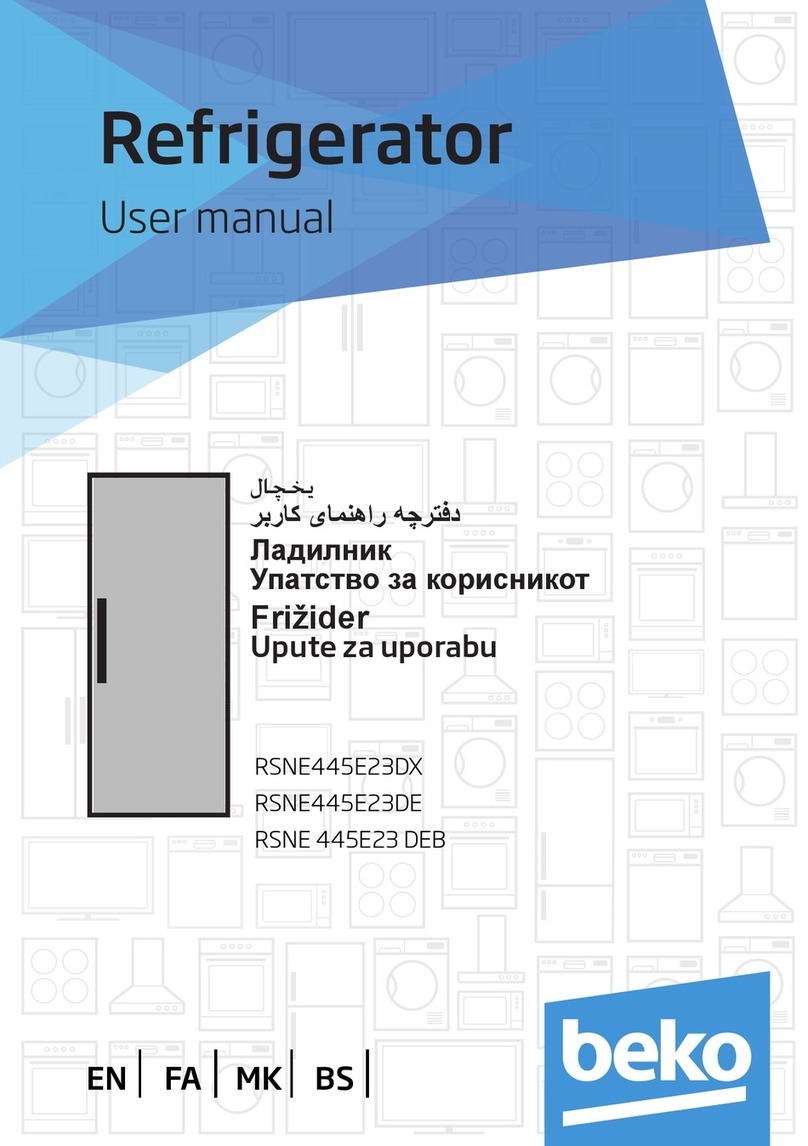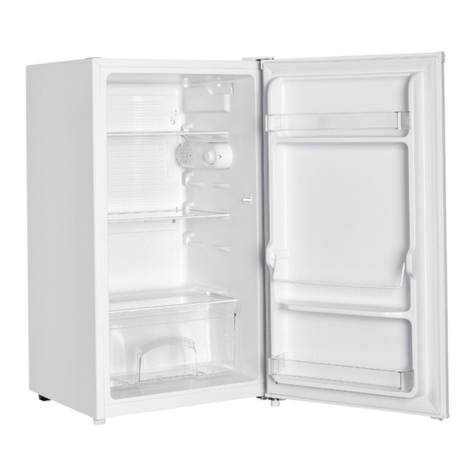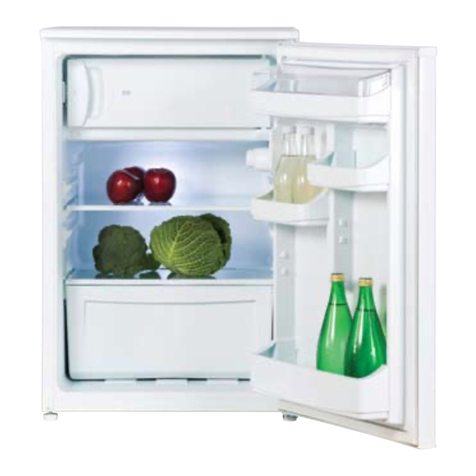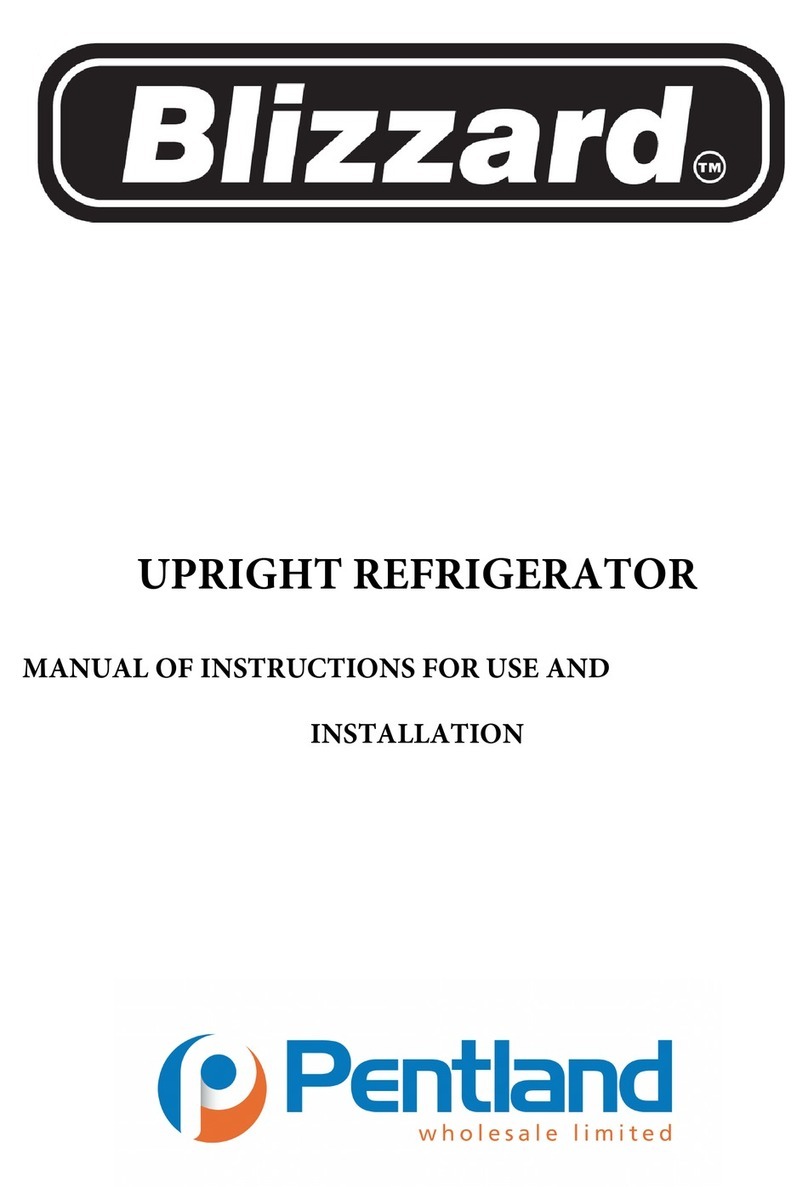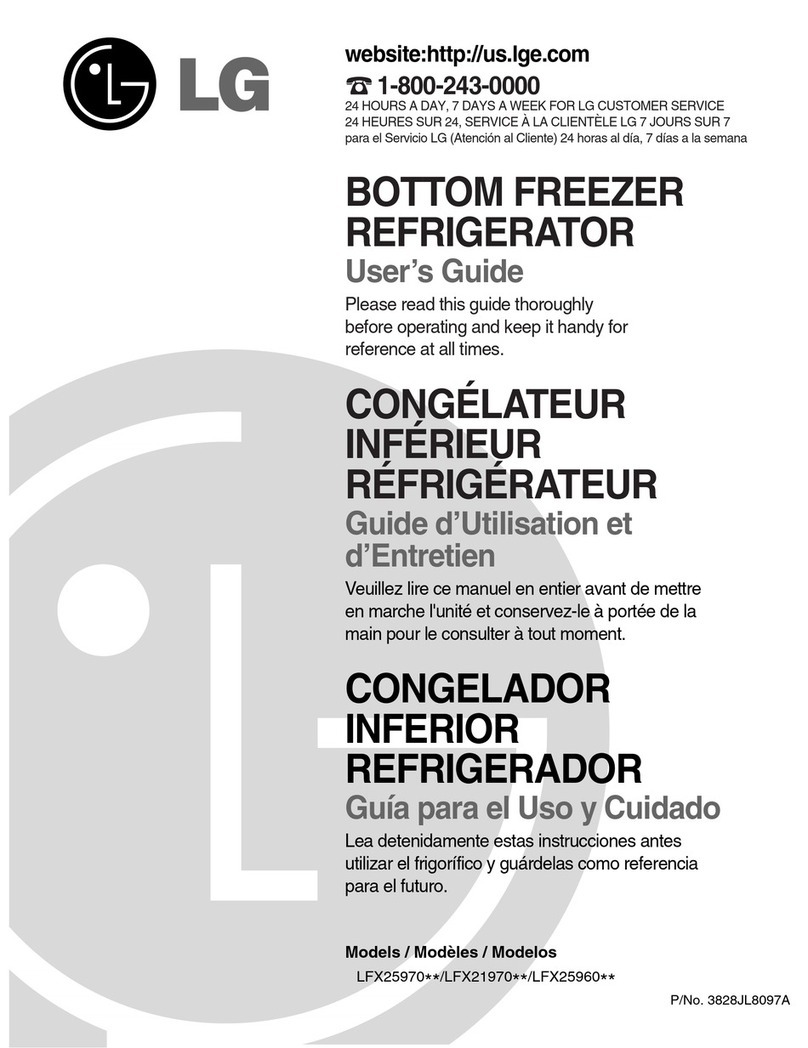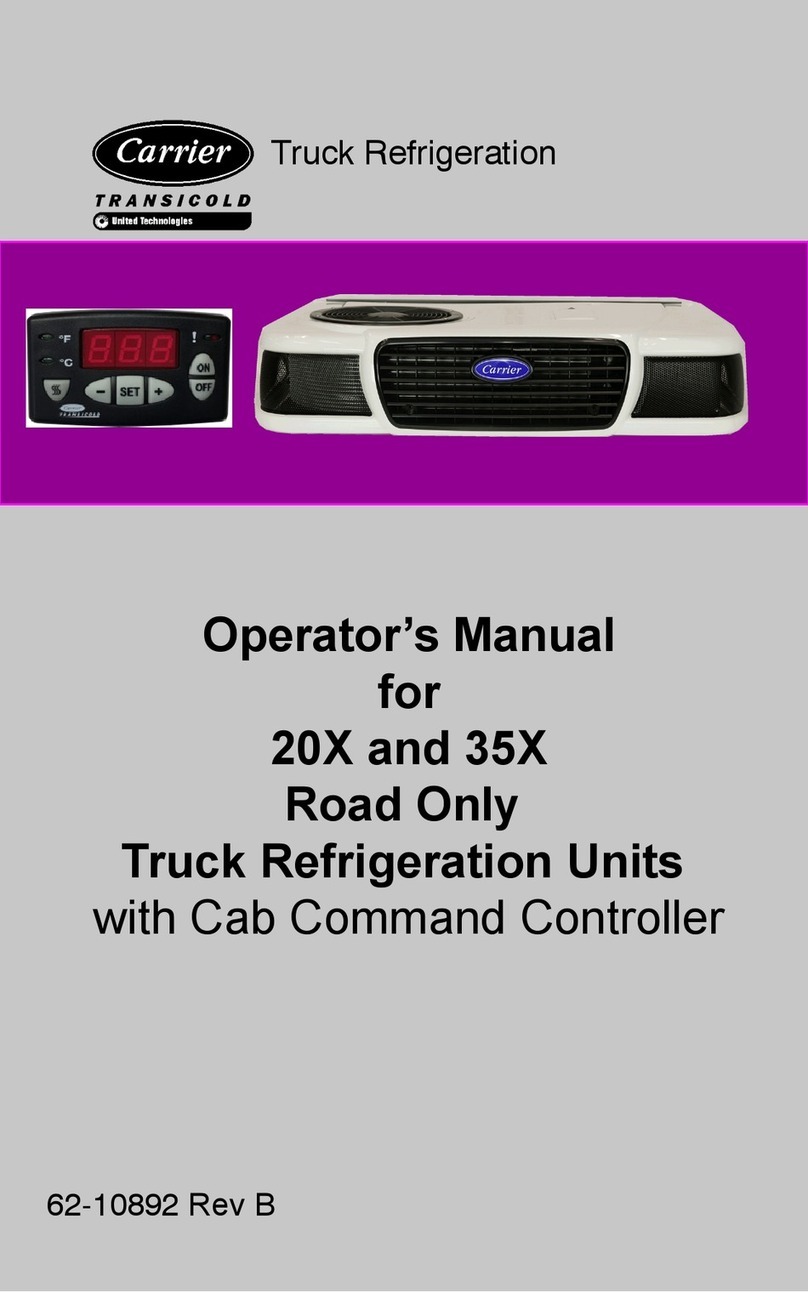ChiQ CQRT09Y1GD1W User manual

INSTRUCTION MANUAL
Model No.: CQRT09Y1GD1W/CQRT09Y1GD1S

IMPORTANT SAFETY INSTRUCTIONS
WARNING 1 Read these instructions.
1.Read these instructions.
2. Keep these instructions.
3.Heed all warnings.
4.Follow all instructions.
5. Do not use your refrigerator near water.
6.Clean only with a damp cloth.
7.Do not block any ventilation openings. Install in accordance with the manufacturer’s instructions.
8. Do not install near any heat sources, such as radiators, heat registers, stoves, or other apparatus (including amplifiers)
that produce heat.
9.Do not defeat the safety purpose of the polarized or grounding-type plug. A polarized plug has two blades with one
wider than the other. A grounding type plug has two blades and a third grounding prong. The wide blade or the third
prong is provided for your safety. If the provided plug does not fit into your outlet, consult an electrician for
replacement of the obsolete outlet.
10. Protect the power cord from being walked on or pinched, particularly at plugs, convenience receptacles, and the point
where it exits from your refrigerator.
11. Do not attempt to modify or extend the power cord of your refrigerator.
12. Unplug your refrigerator during lightning storms or when it will not be used for long periods of time.
13. Make sure that the available AC power matches the voltage requirements of your refrigerator.
14. Do not handle the plug with wet hands. This could result in an electric shock.
15. Unplug the power cord by holding the plug, never by pulling the cord.
16. Turn off your refrigerator before unplugging it.
17.Refer all servicing to qualified service personnel. Servicing is required when your refrigerator has been damaged in
any way, such as the power-supply cord or plug is damaged, liquid has been spilled or objects have fallen into your
refrigerator, your refrigerator has been exposed to rain or moisture, does not operate normally, or has been dropped.
18. To reduce the risk of fire or electric shock, do not expose your refrigerator to rain, moisture, dripping, or splashing, and
no objects filled with liquids should be placed on top of it.
19 Do not use extension cords or ungrounded (two prong) adapters. If the power cord is too short, have a qualified
electrician install an outlet near your refrigerator. Use of an extension cord can negatively affect your refrigerator’s
performance.
20Your refrigerator is not intended for use by persons (including children) with reduced physical, sensory, or mental
capabilities, or lack of experience and knowledge, unless they have been given supervision or instruction concerning
use of your refrigerator by a person responsible for their safety.
21 Children should be supervised to ensure that they do not play with your refrigerator.
22If the power cord is damaged, it must be replaced by the manufacturer, its service agent, or similarly qualified person,
inorder to avoid a hazard.

WARNING
Electric Shock Hazard
Failure to follow these instructions can result in electric shock, fire, or death.
1.WARNING–Keep ventilation openings, in both your refrigerator and the built-in structure, clear of obstruction.
2.WARNING–Do not touch the interior of your refrigerator with wet hands. This could result in
frostbite.
3.WARNING–Do not use mechanical devices or other means to accelerate the defrosting process, other than those
recommended by the manufacturer.
4.WARNING–Do not damage the refrigerant circuit.
5.WARNING–Do not damage the refrigerant tubing when handling, moving, or using your refrigerator.
6.WARNING–DANGER—Never allow children to play with, operate, or crawl inside your refrigerator.
Risk of child entrapment. Before you throw away your old refrigerator:
•Take off the door.
•Leave the shelves in place so that children may not easily climb inside.
7. WARNING—Do not use electrical appliances inside the food storage compartments of the appliance unless they are of
the type recommended by the manufacturer.
8.Unplug your refrigerator before carrying out user maintenance on it.
9.If a component part is damaged, it must be replaced by the manufacturer, its service agent, or similar qualified persons
in order to avoid a hazard.
10.Follow local regulations regarding disposal of your refrigerator due to flammable refrigerant and gas. All refrigeration
products contain refrigerants, which under the guidelines of federal law must be removed before disposal. It is the
consumer's responsibility to comply with federal and local regulations when disposing of this product.
11. Do not store explosive substances such as aerosol cans with a flammable propellant in this appliance.
12 .This appliance is intended to be used in household and similar applications such as
– staff kitchen areas in shops, offices and other working environments.
– farm houses and by clients in hotels, motels and other residential type environments.
– bed and breakfast type environments.
– catering and similar non-retail applications.
Grounding requirement
Your refrigerator must be grounded. Your refrigerator is equipped with a cord having a grounding wire with a grounding
plug. The plug must be inserted into an outlet that is correctly installed and grounded.
Incorrect use of the grounding plug can result in a risk of electric shock. Consult a qualified electrician or service person if
the grounding instructions are not completely understood, or if doubt exists as to whether your refrigerator is correctly
grounded.
Locks
If your Freezer is fitted with a lock, to prevent children being entrapped keep the key out of reach and not in the vicinity of
the appliance. If disposing of an old Freezer break off any old locks or latches as a safeguard.
Climate Range
The information about the climate range of the appliance is provided on the rated plate. It indicates at which ambient
temperature (that is, room temperature, in which the appliance is working) the operation of the appliance is optimal
(proper).
Climate range
Permissible ambient
temperature
SN
from +10°C to +32°C
N
from +16°C to +32°C
ST
from +16°C to +38°C
T
from +16°C to +43°C
Note:The limit values of the range of ambient temperature for the climate classes for which the refrigerating appliance is
designed and the fact that the internal temperatures could be affected by such factors as the location of the refrigerating
appliance, ambient temperature and the frequency of door opening, and, if appropriate, a warning that the setting of any
temperature control device might have to be varied to allow for these factors;
Electrical Connection
WARNING
Improper use of the grounded plug can result in the risk of electrical shock. If the power cord is damaged, have it
replaced by an authorized service center.
This refrigerator should be properly grounded for your safety. The power cord of this refrigerator is equipped with a
three-prong plug which mates with standard three prong wall outlets to minimize the possibility of electrical shock.
Do not, under any circumstances, cut or remove the third ground prong from the power cord supplied.
This refrigerator requires a standard 115V A.C. ~/60Hz electrical outlet with three-prong ground.
This refrigerator is not designed to be used with an inverter.
The cord should be secured behind the refrigerator and not left exposed or dangling to prevent accidental injury.
Never unplug the refrigerator by pulling the power cord. Always grip the plug firmly and pull straight out from the

receptacle.
Do not use an extension cord with this appliance. If the power cord is too short, have a qualified electrician or service
technician install an outlet near the appliance. Use of an extension cord can negatively affect the performance of the
unit.
Prepare with requirements
Installation Location
When selecting a position for your Fridge/Freezer you should make sure the floor is flat and firm, and the room is well
ventilated. Avoid locating your Fridge/Freezer near a heat source, eg. cooker, boiler or radiator.Also avoid direct sunlight
in out-buildings or sun lounges. If you are placing your Fridge/Freezer in an out-building such as a garage or annex
ensure that the Fridge/Freezer is placed above the damp course, otherwise condensation will occur on the Fridge/Freezer
cabinet. Never place the Fridge/Freezer in a wall recess or into fitted cabinets or furniture. When your Fridge/Freezer is
working, the grille at the back may become hot and the sides warm. Therefore, the back part of the refrigerator / freezer
must be installed at least 30mm of free space, both sides should be left more than 300mm. Do not drape the
Fridge/Freezer with any covering.
Dimensions in mm
W
D
H
A
B
C(
°
)
E
F
545
590
1700
845
1095
125
50
100
Note:Figure 1, Figure 2 only as a product space demand size schematic diagram.
Leveling the Fridge/Freezer
If the Fridge/Freezer is not level, the door and magnetic seal alignment will be affected and may cause
you Fridge/Freezer to work incorrectly. Once the Fridge/Freezer is placed in its final location, adjust the
leveling feet at the front by turning them.
Cleaning before use
Wipe the inside of the Freezer with a weak solution of bicarbonate of soda. Then rinse with warm water using a damp
sponge or cloth. Wash the baskets and shelves in warm soapy water and dry completely before replacing in the Freezer.
The external parts of the Freezer can be cleaned with wax polish.
Before plugging in YOUMUST
Check that you have a socket which is compatible with the plug supplied with the Freezer. IBefore switching on!
DO NOT SWITCH ON UNTIL FOUR HOURS AFTER MOVING THE FREEZER.
The coolant fluid needs time to settle. If the appliance is switched off at any time, wait 30 minutes before switching back on
to allow the coolant fluid to settle.
Before filling your Freezer
Before storing foods in your Freezer, turn the Freezer on and wait for 24 hours, to make sure it is working properly and to
allow the Freezer to fail to the correct temperature.
INTRODUCTION
Before use
Please read these instructions and the Safety guidelines on page 1 carefully before using your new Fridge/Freezer. The
Fridge/Freezer is for indoor, domestic use only.
General Description of Refrigerator
No Description
1 Freezer Shelf
2 Thermostat
3 Refrigerator Glass Shelf
4 Crisper Cover
5 Salad Crisper
6 Adjustable Foot
7 Little Bottle Rack
8 Upper Bottle Rack
9 Bottom Bottle Rack
10 Egg tray

5
START
The temperature inside the refrigerator is controlled by the potentiometer installed in the refrigerated room. The
temperature inside the refrigerator varies depending on the opening and closing doors of the refrigerator, the ambient
temperature, and the place of placement.
Under normal conditions, considering the food preservation and refrigerator energy saving, spring and summer, we
recommend the use of refrigerated room temperature adjustment in the "MED" file.
In winter, the freezer can be placed between MED and MAX.
During the actual use, the freezer air adjustment lever may get frozen as a result of high humidity or frequent opening of
the door. In such case, do not adjust the air lever by force; Instead, you are suggested to heat the air adjustment lever
locally using a hot towel to make the frozen air lever thaw before adjusting it, so as to avoid it from
being damaged.
Refrigeration chamber temperature adjustment
1. When the refrigerator temperature adjustment knob from the "MAX" to the "MIN" , the refrigerator
temperature gradually increased.
2. When you want to strengthen the refrigeration room cooling, the refrigerator temperature
adjustment knob to "MAX" direction adjustment, so that the compressor running time will be
extended, the refrigerator temperature will be reduced accordingly.
Freezer temperature adjustment
1, When the refrigerator temperature control knob to remain in the same position, adjust the
settings freezer volume slider in position "MAX", will provide the greatest amount of freezing cold,
which leads to the lowest temperature in the freezing chamber.
2, When the refrigerator temperature control knob to remain in the same position, adjust the
settings freezer volume slider in position "MIN", will provide the minimum amount of cold freezer,
which resulted in the highest temperature in the freezing room.
IN USE
1. The appliance might not operate consistently (possibility of defrosting of contents or temperature becoming too warm
in the frozen food compartment) when sited for an extended period of time below the cold end of the range of
temperatures for which the refrigerating appliance is designed
2. The information about the climate range of the appliance is provided on the rated plate.
3. The fact that the internal temperatures could be affected by such factors as the location of the refrigerating appliance,
ambient temperature and the frequency of door opening, and, if appropriate, a warning that the setting of any
temperature control device might have to be varied to allow for these factors
4. The fact that effervescent drinks should not be stored in food freezer compartments or cabinets or in
low-temperature compartments or cabinets, and that some products such as water ices should not be consumed too
cold
5. The need to not exceed the storage time(s) recommended by the food manufacturers for any kind of food
Storage of food
1. The cook dishes can be put into refrigerator to keep fresh after their temperature decreases to room temperature.
2. Egg pockets and bottle pockets for eggs, butter, milk and bottle drinks,etc. Storage of food or containers should be
left between the gap, so as not to affect the air-conditioning cycle
3. The arrangement of food for storage, in particular the need to avoid cross-contamination, such as food to be stored
should be wrapped with clean plastic film or fresh keeping paper, then distributed to several frames even to avoid
contamination and the loss of water and smell mixture.
4. Fruits and vegetables should be put into the salad crisper to prevent excessive evaporation of water and freshness.
5. Cool hot food down to the room temperature before storing otherwise consumption of electricity will increase and
would lead to frost forming inside.
6. In the case of refrigerating appliances with chill compartment, a statement to the effect that some types of fresh
vegetables and fruits are sensitive to cold, and that therefore they are not suitable for storage in this kind of
compartment.
7. The fact that effervescent drinks should not be stored in food freezer compartments or cabinets or in
low-temperature compartments or cabinets, and that some products such as water ices should not beconsumed too
cold
Tips for keeping food perfect in the Fridge
1. Cooked meats should always be stored on a shelf above raw meats to avoid bacterial transfer. Keep raw meats on a
plate which is large enough to collect juices and cover it with cling film or foil.
2. This allows cold air to circulate around the Fridge, ensuring all parts of the Fridge are kept cool.
3. To prevent transfer of flavors and drying out, food should be separately packed or covered. Fruit and vegetables
need not be wrapped.
4. Allow pre-cooked food to cool down before placing in the Fridge. This will help to stop the internal temperature of the
Fridge from rising.
5. To prevent cold air escaping, try to limit the number of times you open the door. When retuning from shopping, sort
foods to be kept in your Fridge before opening the door. Only open the door to put food in or take it out.
Interruption of power supply or failure of the refrigerating system
The care required with regard to frozen food in storage in the event of an extended non-running of the refrigerating

6
appliance (interruption of power supply or failure of the refrigerating system)
1. Do not open the refrigerator door as much as possible so that even in hot summer food can be safely and freshly
kept for hours.
2. If you have a power outage notice in advance:
1) Please an hour in advance will be temperature control stalls transferred to a strong cold position, so that the
refrigerator fully frozen. (Note that this time do not store new food!) To be restored after the timely supply of
temperature control gear to the original location.
2) You can also make some ice, with a watertight container, and put it in the upper part of the freezer. So that it is
necessary to extend the time for fresh food to be deposited.
Preparations for freezing
1. Leave cooked food to cool completely.
2. Chill food in a Fridge before freezing if possible.
3. Consider how you want to cook the food before freezing it.
4. Don’t freeze food in metal containers as you may want to microwave it straight from the Freezer.
5. Use special Freezer bags available from supermarkets, Freezer film, polythene bags, plastic containers, aluminum
foil for acidic foods(such as citrus fruits). Do not use thin cling film or glass. Do not use used food containers (unless
cleaned thoroughly first).
6. Exclude as much air from the container as possible. You could buy a special vacuum pump which sucks excessive
air out of the packaging.
7. Leave a small amount of “air space” when freezing liquids, to allow for expansion.
8. You can use the space in the Freezer most efficiently if you freeze liquids(or solids with liquids, such as stew) in
square blocks. This is known as “performing” Pour the liquid into a polythene bag which is inside a square sided
container. Freeze it like this, then remove it from the container and seal the bag.
Tips for shopping for frozen foods
1. When you are buying frozen food, look at the Storage Guidelines on the packaging. You will be able to store each
item of frozen food for the period shown against the star rating. This is usually the period stated as “Best, Before”,
found on the front of the packaging.
2. Check the temperature of the frozen food cabinet in the shop where you buy your frozen foods.
3. Make sure the frozen food package is in perfect condition.
4. Always buy frozen products last on your shopping trip or visit to the supermarket.
5. Try to keep frozen food together whilst shopping, and on the journey home as this will help to keep the food cooler.
6. Don’t buy frozen food unless you can freeze it straight away. Special insulated bags can be bought from most
supermarkets and hardware shops. These keep frozen food cold for longer.
7. For some foods, thawing before cooking is unnecessary. Vegetables and pasta can be added directly to boiling water
or steam cooked. Frozen sauces and soups can be put into a saucepan and heated gently until thawed.
8. Use quality food and handle it as little as possible. Freeze food in small quantities, it freezes faster, takes less time to
thaw and enables you to eat it in the quantity you need.
9. First, estimate the amount of food you will be freezing. If you are freezing large amounts of fresh food, remember to
turn the control dial to the low temperature range. This will lower the temperature in the Freezer, freezing your food
quicker and helping to keep the goodness in. However you should do this sparingly to conserve energy.
Defrosting
This appliance is designed as automatic defrosting ,no need to defrost by hand.
Moving the Fridge/Freezer
Location
Do not place your Fridge/Freezer near a heat source, eg. Cooker, boiler or radiator. Also avoid direct sunlight in
out-buildings or sun lounges.
Leveling the Fridge/Freezer
Make sure the Fridge/Freezer is level. Use the rotating leveling feet at the front. If the Fridge/Freezer is not level, the
doors and magnetic seal alignments will be affected and may cause your Fridge/Freezer to work incorrectly.
After the Fridge/Freezer is in place, it can be used after 4 hours. This allows time for the coolant to settle.
Installation
Don’t cover or block the vents or grilles of your appliance.
If you're not at home for a long time
•If the appliance will not be used for several months, turn off the refrigerator first and then unplug the unit from the wall
outlet.
•Remove all the food.
•Clean and dry the interior thoroughly. To prevent odor and mold growth, leave the door open slightly: blocking it
open if necessary or have the door removed.
•Keep the cleaned fridge in a dry, ventilated place away from the heat source, where the fridge is placed smoothly
and do not place heavy objects on top of the fridge.
•Use extreme caution in the case of children. The unit should not be accessible to child’s play.
Save energy
1. Install the refrigerator in the coolest part of the room, out of direct sunlight and away from heating ducts or registers.
Do not place the refrigerator next to heat-producing appliances such as a range, oven or dishwasher.
2. The refrigerator door should remain open only as long as necessary; do not place hot food inside the refrigerator.
3. Organize the refrigerator to reduce door openings .Remove as many items as needed at one time and close the
door as soon as possible.
4. The refrigerator door should be properly closed to avoid increased energy consumption, and the formation of excess
ice and / or condensation inside.

7
5. Constantly circulating cold air keeps the temperature homogenous inside the refrigerator. For this reason, it is
important to properly distribute the food, to facilitate the flow of air.
6. Cover foods and wipe containers dry before placing them in the refrigerator. This cuts down on moisture build-up
inside the unit.
7. Do not overcrowd the refrigerator or block cold airvents. Doing so causes the refrigerator to run longer and use more
energy. Shelves should not be lined with aluminum foil, wax paper or paper toweling. Liners interfere with cold air
circulation, making the refrigerator less efficient, which could cause food spoilage.
8. The arrangement of food for storage and for freezing, where applicable, particularly including advice that food to be
frozen is not to be placed in direct contact with food in storage and, if appropriate, that it could be necessary to reduce
the quantity to be frozen if freezing every day is anticipated.
9. During prolonged absences (example: vacations), it is advisable to disconnect the refrigerator, remove all the food,
and clean it . The door should be left slightly open to avoid mold and unpleasant odors. This will not affect the
refrigerator when it is reconnected.
10. During short absences (example: holidays), the refrigerator can remain on. However, remember that prolonged power
outages may occur while you are gone.
11. The door to the evaporator clearance can be used to store food.
12. The storage time(s) recommended by the food manufacturers for any kind of food and particularly for commercially
quick-frozen food in food-freezer and frozen-food storage compartments or cabinets.
13. The precautions necessary to prevent an undue rise in the temperature of the frozen food while defrosting the
refrigerating appliance, such as wrapping the frozen food in several layers of newspaper.
14. The fact that a rise in temperature of the frozen food during manual defrosting, maintenance or cleaning could
shorten the storage life.
15. The care required with regard to frozen food in storage in the event of an extended non-running of the refrigerating
appliance (interruption of power supply or failure of the refrigerating system).
16. It is better wrapping the frozen food in several layers of the glass shelves.
17. The care required with regard to frozen food in stora.
Maintenance and cleaning
1.Internal cleaning
Clean the Fridge/Freezer internally with a weak solution of bicarbonate of soda. Then rinse with warm water using a damp
sponge or cloth and wipe dry. Wash the baskets in warm soapy water and ensure they are completely dry before replacing
in the Fridge/Freezer.
2.External cleaning
Use standard non-abrasive detergent diluted in warm water to clean the Fridge/Freezer exterior.
The grille of the condenser at the back of the Fridge/Freezer and the adjacent components can be vacuumed using a soft
brush attachment.
Do not use harsh cleaners, scouring pads or solvents to clean any part of the Fridge/Freezer
ELECTRICAL INFORMATION
THIS APPLIANCE MUST BE EARTHED.
This appliance is fitted with a plug which will be suitable for use in all houses fitted with sockets to current specifications.
If the fitted plug is not suitable for your socket outlets, it should be cut off and carefully disposed of. To avoid a possible
shock hazard, do not insert the discarded plug into a socket.
This appliance complies with the following EEC Directives.
Servicing
Simple fault analysis and elimination
Not every failure requires technical service personnel to solve the following simple small problem; you can try to solve the
problem.
Case
Inspection
Solutions
•Completely non
refrigeration
•Is power plug off?
•Are breakers and fuses a broken?
•No electricity or line trip?
•Re-plug.
•Opening the door and checking whether the
lamp is lit.
•Abnormal noise
•Is refrigerator stable?
•Does refrigerator reach the wall?
•Adjusting refrigerator’s adjustable feet.
•Off the wall.
•Poor refrigerating
efficiency
•Do you put hot food or too much food?
•Do you open the door frequently?
•Do you clip food bag to the seal of
door?
•Direct sunlight or near a furnace or
stove?
•Is it well-ventilated?
•Temperature setting in too high?
•Putting food into refrigerator when hot food
becomes cool.
•Checking and closing the door.
•Removing the refrigerator from the heat
source.
•Emptying the distance to maintain good
ventilation.
•
Setting to the appropriate temperature.
•Peculiar smell in
refrigerator
•Any spoiled food?
•Do you need to clean refrigerator?
•Do you packed food of strong flavors?
•Throwing away spoiled food.
•Cleaning refrigerator.
•Packing food of strong flavors.
Note: If the above description can't be troubleshooting, do not disassemble the repair yourself. Repairs carried out by
inexperienced persons may cause injury or serious malfunctioning. Contact the local store where your purchase was

8
made. This product should be serviced by an authorized engineer and only genuine spare parts should be used.
When the appliance is not in use for long periods, disconnect from the electricity supply, empty all foods and clean the
appliance, leaving the door ajar to prevent unpleasant smells.
Correct Disposal of this product
This marking indicates that
this product should not be disposed with other household
wastes throughout the EU. To prevent possible harm to the environment or human health
from uncontrolled waste disposal, recycle it responsibly to promote the sustainable reuse
of material resources. To return your used device, please use the return and collection
systems or contact the retailer where the product was purchased. They can take this
product for environmental safe recycling.
This manual suits for next models
2
Table of contents
Other ChiQ Refrigerator manuals
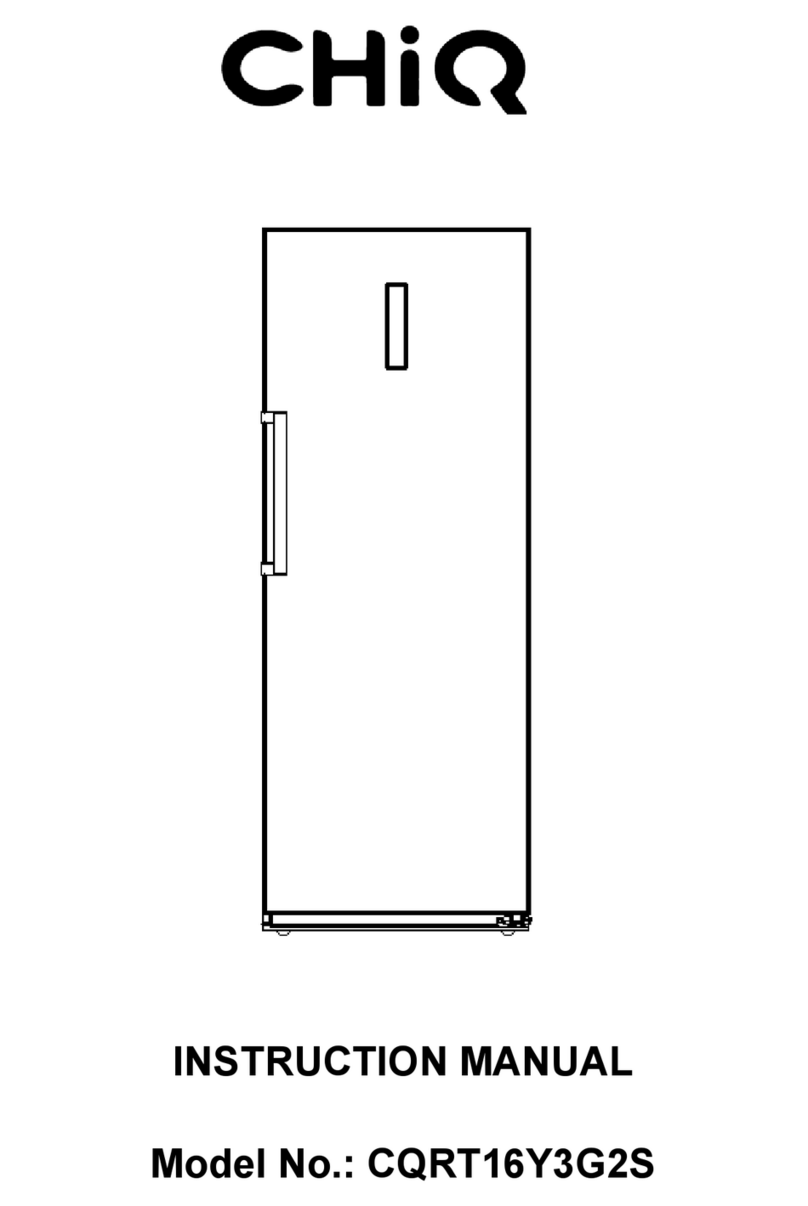
ChiQ
ChiQ CQRT16Y3G2S User manual
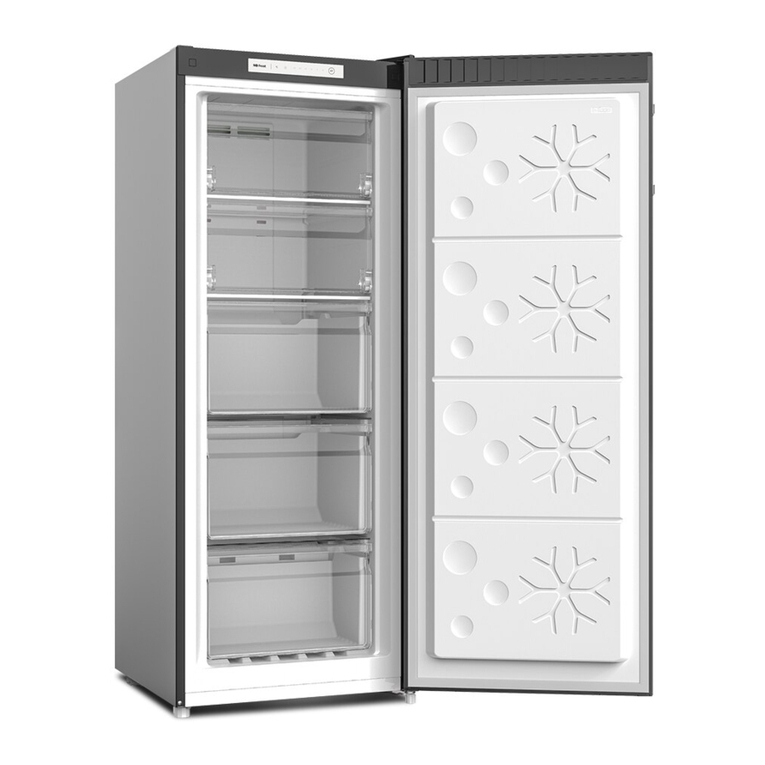
ChiQ
ChiQ FSD166NE4 User manual
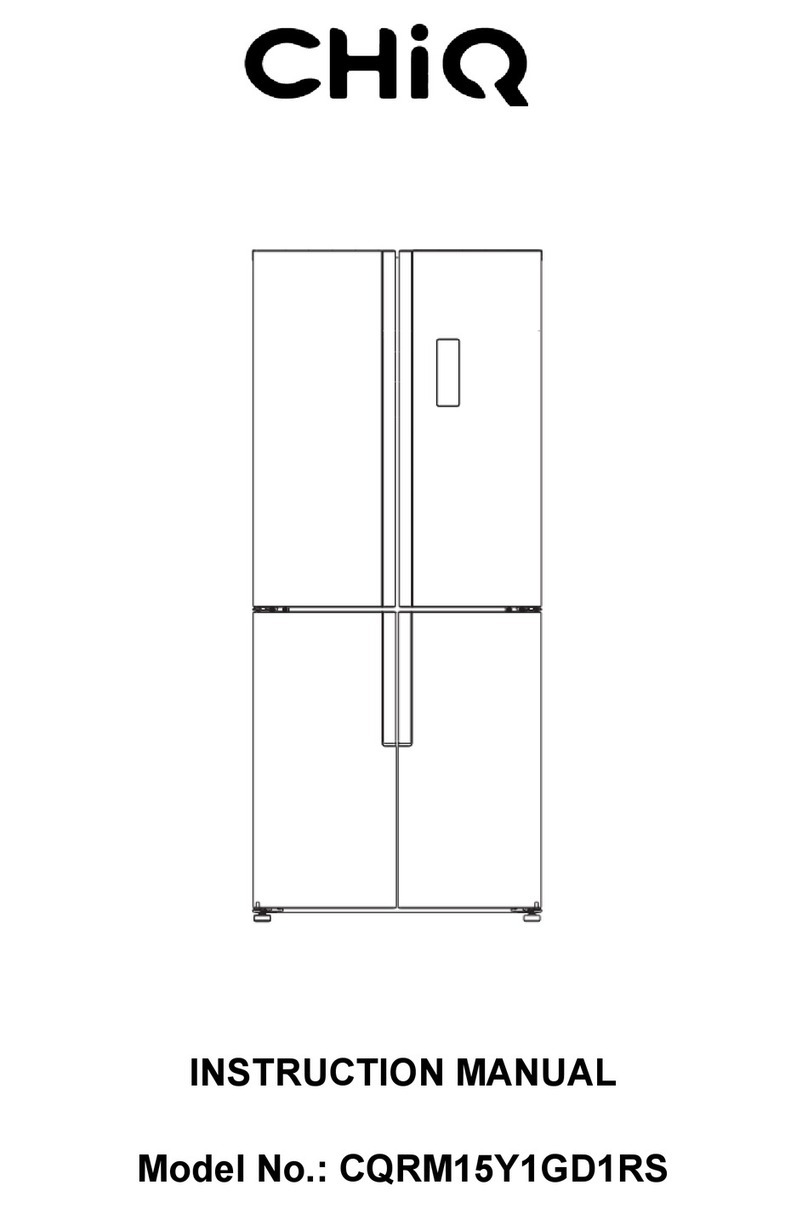
ChiQ
ChiQ CQRM15Y1GD1RS User manual

ChiQ
ChiQ FCD418NE3 User manual

ChiQ
ChiQ FCD418NE4D User manual
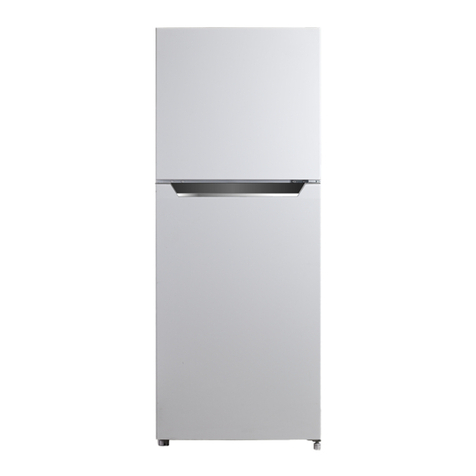
ChiQ
ChiQ CQRT07Z1GD1 User manual

ChiQ
ChiQ FBM250NE42 User manual
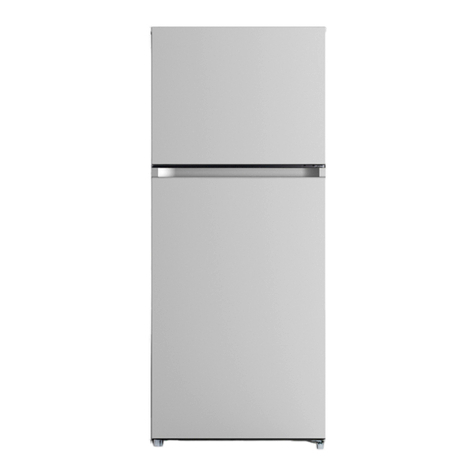
ChiQ
ChiQ CQRT15Y1GD1W User manual

ChiQ
ChiQ CBM251W User manual

ChiQ
ChiQ CTM216W User manual
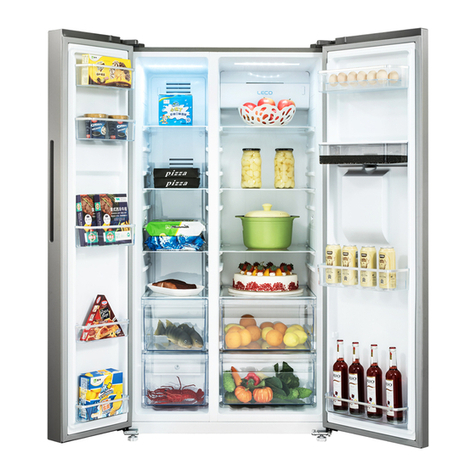
ChiQ
ChiQ FSS559NEI32D User manual
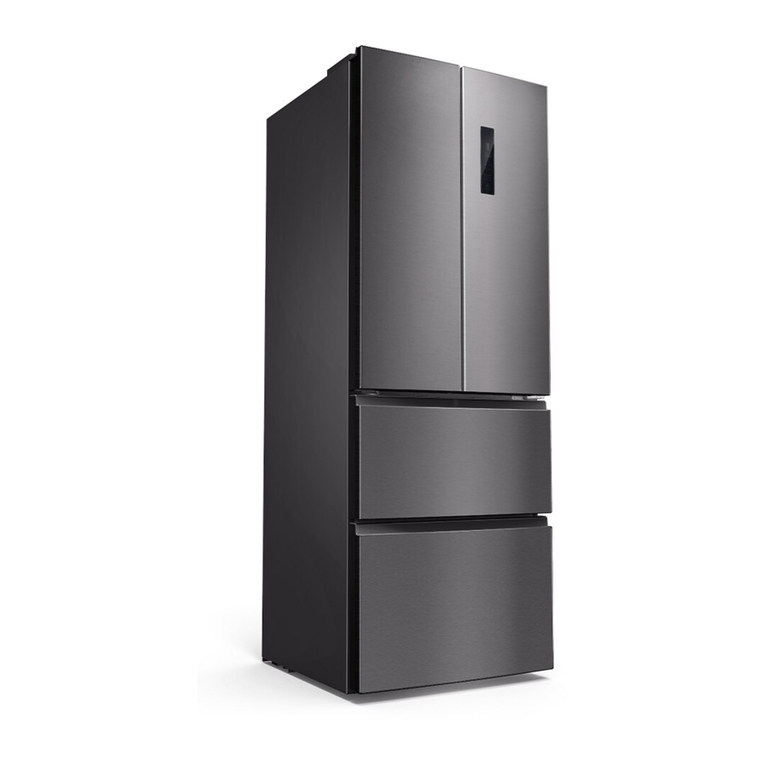
ChiQ
ChiQ CFD337NEI42 User manual
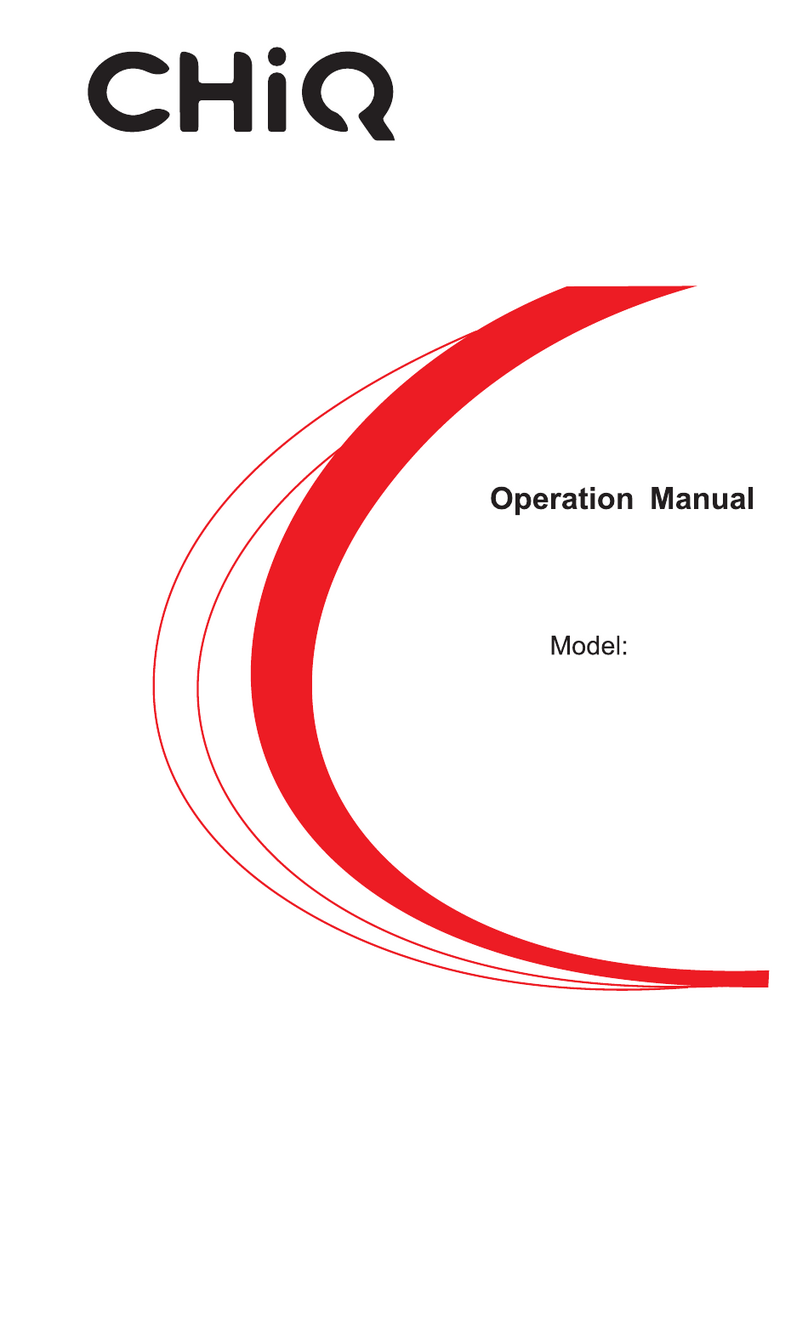
ChiQ
ChiQ CTT107BC User manual
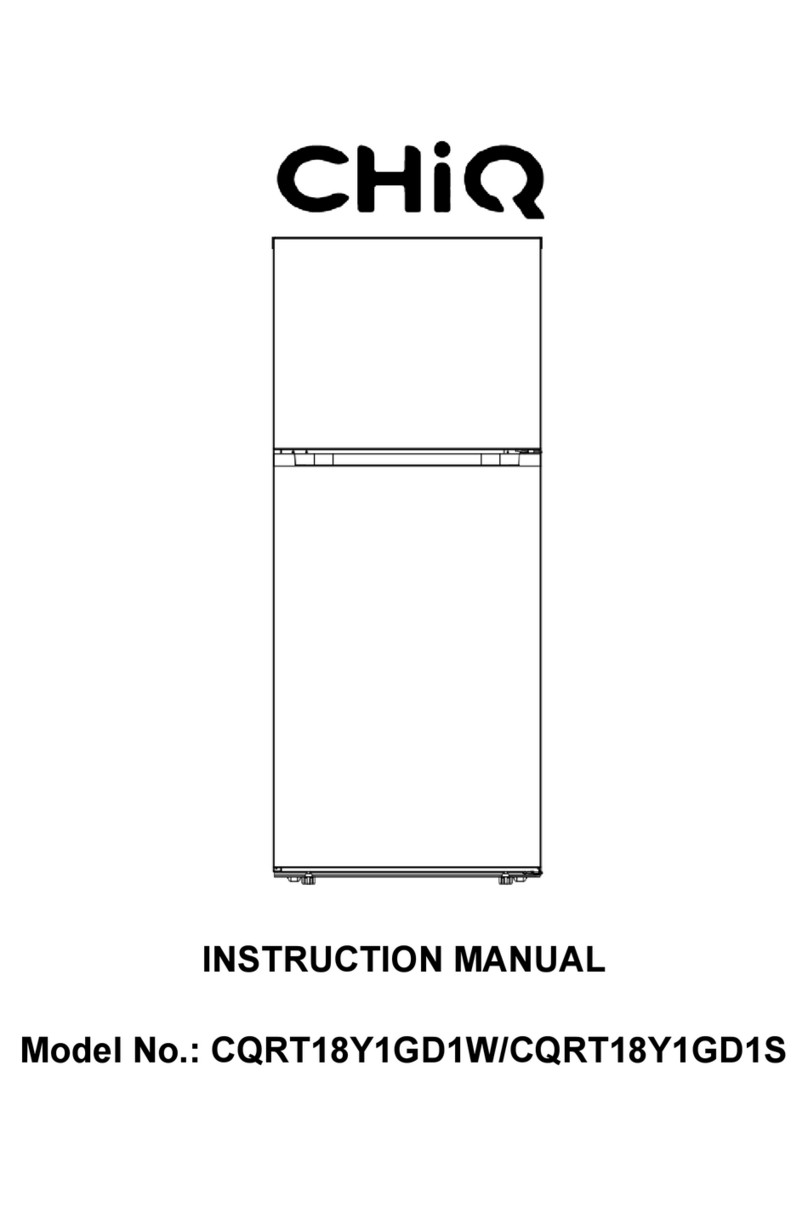
ChiQ
ChiQ CQRT18Y1GD1W User manual

ChiQ
ChiQ CQRT10Y1GD1W User manual
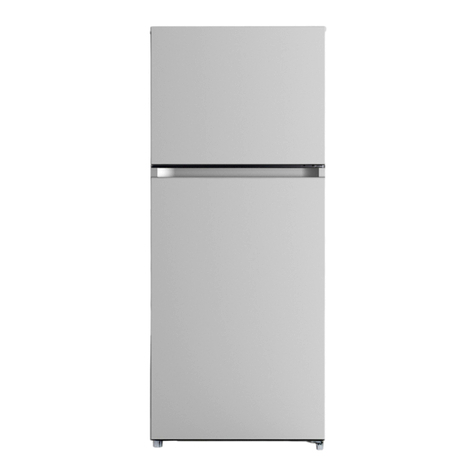
ChiQ
ChiQ CQRT12Y1GD1W User manual
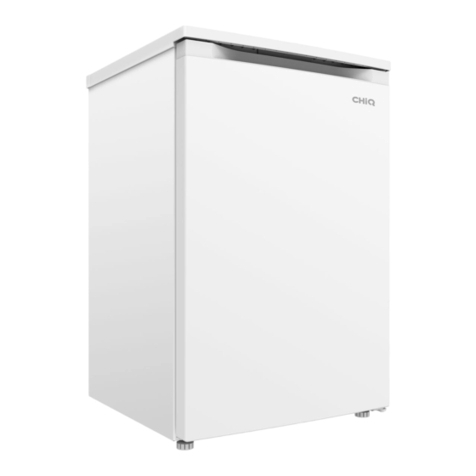
ChiQ
ChiQ CSR102DW User manual

ChiQ
ChiQ CFD502NBS User manual
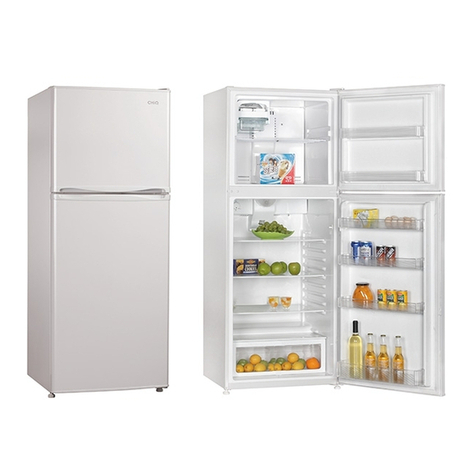
ChiQ
ChiQ CTM400W User manual

ChiQ
ChiQ CQRQ15Y1GD1RS User manual



